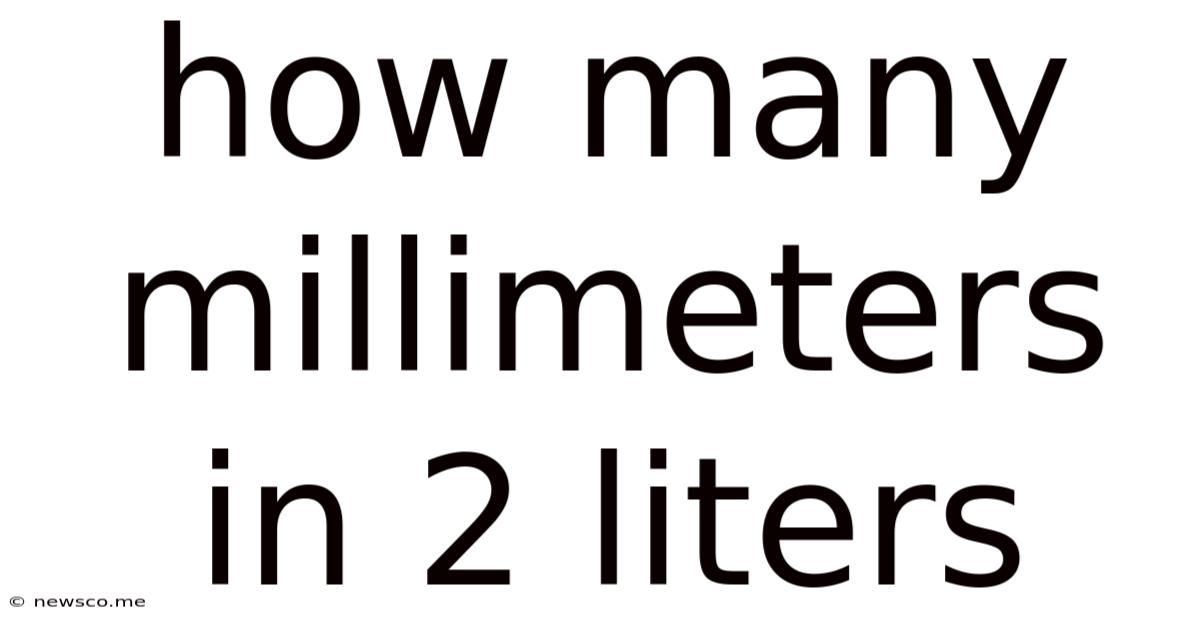How Many Millimeters In 2 Liters
News Co
Apr 25, 2025 · 4 min read

Table of Contents
How Many Millimeters in 2 Liters? Understanding Volume Conversions
The question, "How many millimeters in 2 liters?" is a common one, but it's crucial to understand that it's inherently flawed. Millimeters (mm) measure length, while liters (L) measure volume. You can't directly convert between them without additional information about the shape of the container holding the 2 liters. This article will delve into the reasons why, explore the correct conversion paths for related units, and offer a deeper understanding of volume and its measurement.
Understanding the Units: Length vs. Volume
Before attempting any conversion, it's crucial to grasp the fundamental difference between length and volume:
-
Millimeters (mm): A unit of length in the metric system. One millimeter is one-thousandth of a meter (1 mm = 0.001 m). Think of it as measuring the distance between two points.
-
Liters (L): A unit of volume in the metric system. One liter is defined as the volume of a cube with sides of 10 centimeters (10 cm x 10 cm x 10 cm). This represents the amount of space a substance occupies.
The key takeaway is that you can't convert length directly to volume, just like you can't convert apples to oranges without defining a relationship between them. Trying to directly answer "how many millimeters in 2 liters" is like asking "how many inches in a gallon?" – it's meaningless without further context.
Correct Conversions: Liters to Cubic Millimeters
If the question was intended to ask about converting liters to a volume unit related to millimeters, then the correct approach is to convert liters to cubic millimeters (mm³). A cubic millimeter is a cube with sides of 1 mm each.
Here's how to perform this conversion:
-
Liters to Cubic Centimeters: First, we convert liters to cubic centimeters (cm³). One liter is equal to 1000 cubic centimeters (1 L = 1000 cm³). Therefore, 2 liters are equal to 2000 cm³.
-
Cubic Centimeters to Cubic Millimeters: Next, we convert cubic centimeters to cubic millimeters. Since 1 cm = 10 mm, then 1 cm³ = (10 mm)³ = 1000 mm³. Therefore, 2000 cm³ is equal to 2000 * 1000 mm³ = 2,000,000 mm³.
Therefore, 2 liters are equal to 2,000,000 cubic millimeters (2 x 10⁶ mm³). This is the correct answer to the intended question, addressing the volume aspect.
Exploring Related Volume Conversions
While the primary focus is on liters and cubic millimeters, understanding other related units can provide a more comprehensive picture of volume conversions. Here's a breakdown of some common conversions:
-
Liters to Milliliters (mL): One liter is equal to 1000 milliliters (1 L = 1000 mL). Therefore, 2 liters equal 2000 mL. Milliliters are a more practical unit for smaller volumes.
-
Cubic Meters (m³) to Liters: One cubic meter is equal to 1000 liters (1 m³ = 1000 L). This is a crucial conversion for larger volumes.
-
Gallons to Liters (and vice versa): While not directly related to millimeters, understanding the conversion between the imperial gallon and the metric liter is important. 1 US gallon is approximately 3.785 liters. 1 UK gallon is approximately 4.546 liters.
Practical Applications of Volume Conversions
Understanding volume conversions is essential in numerous fields, including:
-
Science and Engineering: Accurate measurement of liquids and gases is vital in experiments, industrial processes, and designing equipment.
-
Medicine: Dosage calculations and fluid administration rely heavily on accurate volume conversions.
-
Cooking and Baking: Recipes often specify ingredients in both metric and imperial units, requiring conversions for accurate results.
-
Environmental Science: Measuring water flow, pollution levels, and rainfall often involves converting between various volume units.
-
Construction: Estimating materials like concrete, plaster, and paint requires accurate volume calculations.
Advanced Concepts: Irregular Shapes and Volume Calculations
While the previous examples focused on simple conversions, many real-world scenarios involve containers with irregular shapes. Calculating the volume of such containers requires more advanced techniques:
-
Displacement Method: Submerging the object in a liquid (like water) and measuring the volume of displaced liquid provides the object's volume.
-
Geometric Formulas: For containers with known shapes (cylinders, spheres, cones), specific formulas can calculate the volume based on their dimensions. Understanding these formulas is key to accurate volume calculations.
-
Integration (Calculus): For complex shapes, calculus techniques (specifically integration) are needed to determine the volume precisely.
Conclusion: The Importance of Clarifying Units
The original question highlights the importance of precise language when discussing units of measurement. While the intuitive interpretation might lead to an incorrect answer, clarifying that the intended conversion was between liters and cubic millimeters provides a clear path to the solution: 2 liters equals 2,000,000 cubic millimeters. This understanding is vital for accurate calculations and problem-solving across various disciplines. Remember always to pay close attention to the units involved and use the appropriate conversion factors. This will prevent confusion and ensure accurate results. Mastering these conversions is crucial for success in many fields and for navigating everyday life effectively. By understanding the fundamental differences between length and volume, and applying the appropriate conversion methods, you can confidently tackle any volume calculation you encounter.
Latest Posts
Related Post
Thank you for visiting our website which covers about How Many Millimeters In 2 Liters . We hope the information provided has been useful to you. Feel free to contact us if you have any questions or need further assistance. See you next time and don't miss to bookmark.